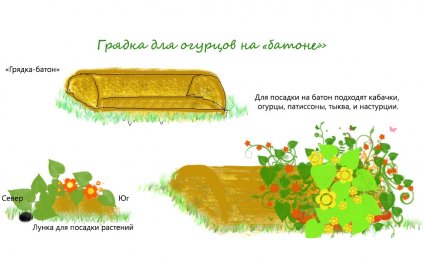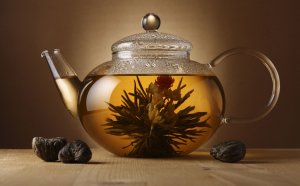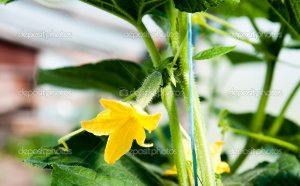
Arrangements For Cucumber Landing
M. V. Motowa
Agronomic phytopathologist of NPF Agrocemtoms, c.b.
The cucumber is the favorite culture in Russia. Distribution takes the lead in public farms (protected soil) and amateur vegetables (plants, gardens). Based on chemical analysis, cucumbers contain 96-97% of water. 100 g of fresh fruit of cucumbers contains: 0, 6 g of protein; 0, 1 g of fat; 2, 5 g of sugar; 0, 1 to 3 g of wrachmal; up to 10 mg vitamin C, with a daily requirement of 60 to 100 mg of human organism. Despite low energy value, cucumbers are very important as dietary food.
In small quantities, nature has planted carotine, vitamin B1, B1, B2, B3, B6, PP, C, potassium salts, sodium, magnesium, iron, silicon, phosphorus, sulphur, yod, petin, cage, enzymes. The cucumbers are not only a food product, but also a cure. The glory of the cucumbers' whole properties has been rooted since the time of the Hippocrat, an ancient Greek thinker, a basic lieutenant of antique medicine.
Multidisciplinary medical experience has shown that fresh fruits of cucumbers:
• Have a heating, anti-flammatory, urine and glacier, as well as a slight weakness;
• Reduce blood pressure, facilitate the removal of cholesterol;
• Helps in the fight against waste;
• Improves thyroid work, stomach-kid tract, reinforces the peristaltic of the bowel;
:: Normalize the exchange of substances for people with obesity;
• Used extensively in cosmetics - helping women look more beautiful and younger.
Time for the planting.
Cucumbers have traditionally grown in a non-residential manner, but landing permits the start of green fees two weeks earlier.
When saline cucumbers are cultivated on the open soil, seeds shall be removed as soon as the soil is warmed to 10-12 °C. When using a concealed mathereal, the crops shall be produced in the first December of June. The depth of the seeds is 2-3 cm. Miranda's hybrids, Shik, Charoday.
I will. Open ground cucumbers They've been cooking since mid-May. The crops start on May 12th. Better use Vyatsky's hybrids and good.
For prisoners of unhydrated greenhouses, the sand starts to cook in the third day of April (seminars in sand after 20 April).
Apollo hybrids are recommended for salad use, well done, Arlequino, Cheboxarec and Volga.
The seeds in the greenhouse sown after 15 May.
Growing up the landing.
The advantage of growing through sand is that the period of vegetation is elongated, the overall yield increases and the reliability of the crop.
Russad grows in separate pots for not more than 25 days. High-organic soil is used for cucumber cultivation. Deep and peat in 1:3 with biogumus and mineral fertilizer. The acidity of the ground shall be within pH 6-6, 5. The seeds shall be planted directly into the throats at depths 1, 5 to 2 cm or rotated in the opium poles and then sprayed in the seed phase. The temperature at which the seeds are grown 24-25 °C, and the outflows occur within 5-7 days. If the seeds are clothed in a 2-3 hour walk, the exits are in three days. During the first period following the upwards (2-3 days) the sludge shall not be swept.
After the peak, the seeds are wet in the interior and mulching. It must be borne in mind that over-humidity has led to the abandonment of roots and the development of diseases. The optimum temperature at the sludge in April-May 20-24°C.
The first feed shall be carried out in the phase of two real sheets; the second shall be three days before boarding:
1. 1 litre of water - 1 g of urea; 2 g crystalline with an addition of 2, 5 ml of potassium gumat;
2. On 1 l of water - 1, 5 g ammonia seplitres; 1, 5 g of serno-oxycomo with the addition of a Goumat Na.
 The cucumbers grown under glass between 5 and 6 days before landing must be adapted to ultraviolet beams. To this end, the sun warms the first day for 2-3 hours, each day the exhibit increases by 1 hour. The scattered scattered scatters badly carry the transplant: the leaves are burnt, become white, the root system is badly damaged and growing.
The cucumbers grown under glass between 5 and 6 days before landing must be adapted to ultraviolet beams. To this end, the sun warms the first day for 2-3 hours, each day the exhibit increases by 1 hour. The scattered scattered scatters badly carry the transplant: the leaves are burnt, become white, the root system is badly damaged and growing.
Before landing, the dissolved shall be filled with ammonium potassium potassium hymato solution (for 10 litres of water 2 g ammonia selitires and 25 ml of potassium gumat). Recently, a variety of liquid fertilizers have been used for feeding plants and adult plants, with macro and micro-fertilization, with the addition of guinea wheat that stimulates the growth of the root system and favours growth and plant development.
Russada grown under optimal conditions has: 4-5 real leaves, 20-22 cm high, 20-25 g.
Preparing for the greenhouse.
Pure, high-organic soils are prepared for high yields. The bases are peat. For the preparation of the soil mixture, the peat shall be known. The standard of communication depends on the acidity of the ground. On acid soil, cucumbers grow poorly, develop well with soil solution near neutral (RH 6, 2-6, 8). In the north-east, we recommend that 3-4 kg of fountains or 4-5 kg of mela be paid for 1 m3 torph. The second component of good soil is bulkhead, or soluble can be used. The third component of the soil mixture is woodland. It uses fertile, structural, good physical properties that are not contaminated with dangerous diseases and pests on the left or peri-urban land.
2 weeks prior to the planting of the planting, beacons and mineral fertilizers (superphosphate; Kalimagnesia) are added to the ground. Instead of salimagnetics, you can use sulky and magical sulky. The mixture is intermittent and lasts 7-10 days. Nitrogen fertilizers contribute to formation a week before landing. Ammonia seplitre flow rate - 6 kg/ 4.5 m3 of prepared soil. The grunt in the greenhouse can be used for 5-6 years or more.
Drinks or straws are made each year in spring to maintain the slurry structure of the soil. Fishing material is cooking in the fall. It is known that the flame retardants or the straw in the introduction are associated with nitrogen and transform it into an inaccessible form for planting, so the addition of nitrogen fertilizers is a prerequisite. 2 kg of urea or 3 kg of ammonia selitis are supplied by 3 m. When the fertilizers are mixed with the opium, they need to be wetted. The prepared deer covers the film and leaves it on winter. Spring's on the bays and they're digging. The refrigerating material may also be used as a cross, top peat, crushed wood.
Landing scheme.
Vegetable crops, including cucumbers, depend on the intensity of photosynthesis, especially when planted in the greenhouse. The main influence of photosynthesis is known to have on plant lighting. For the most optimum lighting of plants, it is necessary to correctly dispose of the heater and effectively house the plants. The fuel must be located from the east to the west, it is desirable to have protection against the winds on the north. The heater's transverse, the cucumbers are tightened. Distance between the scapaler is 50 cm, between the two papaler, 100 cm.
Apollo hybrids, Arlequino, Cheboxard and Volzhsky are planted at 2.7 plants per 1 m2.
100x50/2 landing scheme x 40 cm. The plants are planted strictly under the scapular in the digested moons. Distance between plants 40 cm.
Gibrida Vyatsky, well done, and Shik has a strong verbal bleed. They are planted at 1, 8 plants per 1 m2. It's better to place 4.
Before the landing, the moon is flooded with warm water, and a prepared scatter. The interior portion of the sludge mulch the dry soil or the peat. After planting, the plant is not flooded, i.e. moisture in the ground will last 2-3 days depending on temperature. The first tidal shall be conducted within 2 to 3 days in the interior of the heat water (water temperatures 25 to 30 °C) the flow of 100 to 150 ml per plant with the addition of the gumat.
Temperature and nutrition.
The day before the landing, EPIN is being processed to better adapt to adverse conditions. The soil temperature on the day of landing shall be at least 18 °C. If the temperature of the soil in which the young plants are planted is long below 14-16 °C, the scatter will engulf and may die. The surviving plants will have a weak root system and will not be able to feed the staples, or plants can eclipse when a predominantly female flower is formed at the growth point, and the peak of the young plant ceases to grow.
Optimal temperature for the first week after landing 20-22°C. In a week when new leaves were created and the growth of the root system increased, temperatures need to be reduced to 18-20 °C. Gibrida Vyatsky, good for you, Shik, Charoday, does not reduce growth at a temperature decrease to 16 °C.
From the time of harvest, the reaction of plants to temperature changes. To obtain the maximum yield, the temperature has to be reduced from the higher area to the lower area, which is due to the fact that, at a high temperature, the greens grow so fast that they have strong competition for assimilate. This is the result of the uneven formation of the fruit: after the removal of the cucumbers from the pelet, a long pause is emerging, which may negate the benefits of early harvesting. In addition, early plant ageing often occurs in such cases.
In order to produce early and high yields, therefore, high temperatures are recommended before cleaning begins and subsequently reduced. The cultivation of cucumbers in captive shelters without heating in the north-east can begin from mid to late May.
After boarding, for 10 to 12 days, there is a small tidal in the bottom, at which time it is important to form a root system. The root system grows well and develops in vomit, with good soil aeration.
Moisture may lead to extinction and rotating roots. The growth of the first greens is necessary to increase the flow. The food starts three weeks after the planting.
Table 1.
Feeding of cucumbers in the captive heater (fertilization of mineral fertilizers in grams per 10 litres of water)
Name of mineral fertilizers
June
July
August
10
20
30
14
21
28
24
Ammonia selita
15
Kaliya Sernoquis
Magnosis
Crystallin.
40
50
Humat K or Na
25 ml
RELATED VIDEO


Share this Post
Related posts
Fertilizer For Cucumbers
Among the lucky ones, the view is that cucumbers do not grow, that they are very demanding for fertilizers and soils. In…
Read MoreProduction Cucumber
The cucumber is good not only in the greenhouse, but also on the open soil, but it is assured by the villager of the Selling…
Read More









